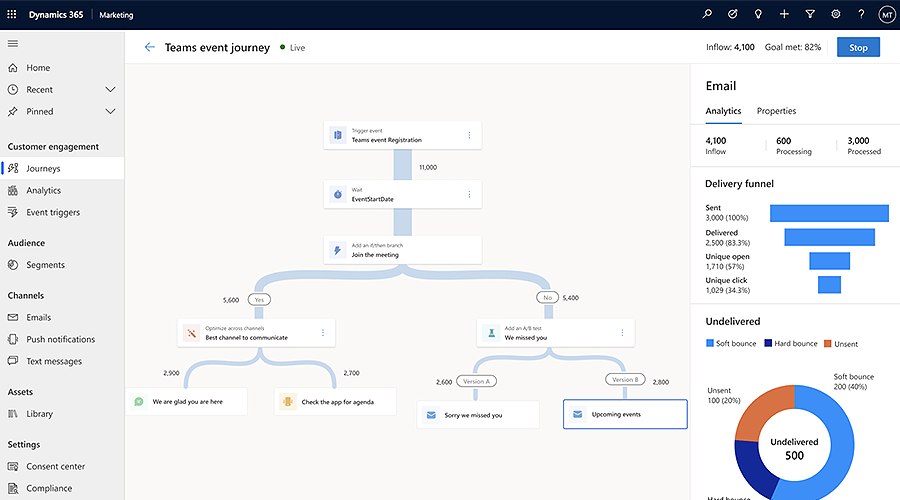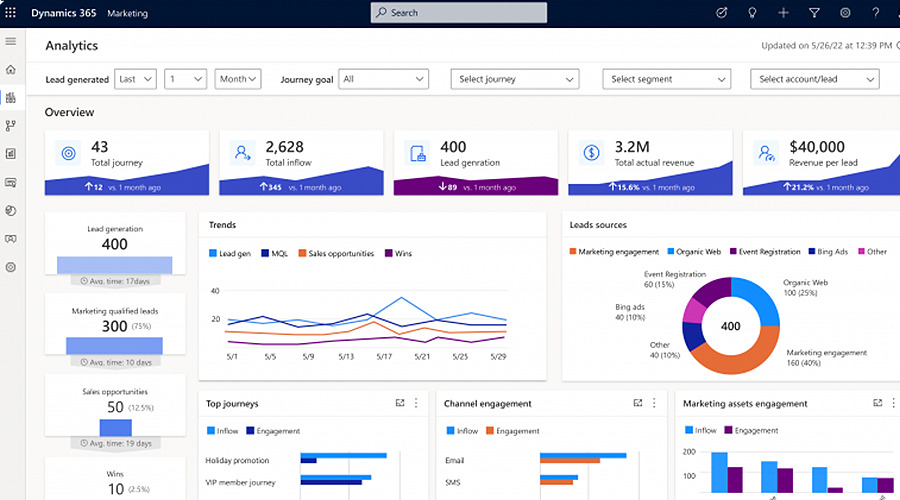In today’s customer landscape, working in silos is no longer adequate for consistently delighting customers and generating leads.
Sales and marketing teams must collaborate, share insights, and prioritise customer-centric strategies.
According to MarketingProfs¹, organisations with tightly aligned sales and marketing experience 36% higher retention and 38% higher win rates.
In this post, you’ll discover how Dynamics 365 addresses 4 common challenges to align sales and marketing teams effectively.
1) Incomplete view of the customer journey.
Teams lack a coherent view of the customer journey when sales and marketing data are managed in disconnected systems. Imagine marketing teams creating content without knowing what resonates with their prospects. Or sales teams engaging with leads without knowing how they interacted with the business across different channels.
Or worse, when marketing content on a website says one thing, and salespeople say something different.
According to a Gartner report², 53% of B2B buyers received different information from their website and salespeople. Sales and marketing teams will struggle to provide customer value when processes are not tightly integrated.
Solution:
Dynamics 365 breaks down collaboration barriers by bringing sales and marketing together in a unified platform that provides visibility of the customer journey. Users can get a 360-degree audience view by tracking each interaction across channels in a unified timeline view.
Although Dynamics Sales and Marketing apps appear distinct, your data is centralised in the Microsoft Cloud platform.
Marketing interactions are easily accessible to sales teams in a contact timeline which allows them to view email opens and clicks alongside other communications.
Sellers can quickly see what customers have read on your website, which PDF they’ve downloaded, and which email they opened. As a result, you can be more proactive and personalise your communications.
Similarly, marketing teams can see if sales have followed up on a qualified lead. This allows them to understand how the conversation progresses or if these prospects must be nurtured further.
It’s not just about viewing data. Teams must meet and talk often. Microsoft has made collaborating in a remote world easier with the embedded Teams chat within Dynamics 365 applications. Share any sales or marketing contact records, bring data into conversations and discuss what is working and what isn’t, all within Dynamics 365 or Teams.
2) Lack of personalisation.
Customers expect personalised service at every step, but can you deliver this?
Perhaps you don’t adequately use CRM data or segment audience profiles and instead, send out generic emails that don’t resonate with your audience. A ‘one size fits all’ marketing strategy can’t be relied upon to generate sales-ready leads.
Lack of personalisation isn’t just sending an irrelevant message. It also means sending the right message at the wrong time. Sending timely communications is made easier by triggering messages that nurture prospects. According to Forrester Research³, companies that excel at lead nurturing generate 50% more sales-ready leads at 33% lower cost. How effective are your nurturing strategies?
Solution:
The challenges faced by each customer segment differ, and you can’t talk to them in a common language. Dynamics Marketing segmentation targets contacts and leads using criteria such as demographics, behavioural trends, industry, location and more.
For example, suppose you are launching a free product trial. You can target contacts who’ve shown interest, but this segment could be refined using data only to target people who visited the product page or opened emails.
This exercise shouldn’t just be limited to marketing. Collaborate with sales to consistently check the CRM data quality and define the segmentation criteria based on customer interactions.
After creating segments, dynamic content capabilities in Dynamics allows marketers to develop hyper-personalised emails quickly. For instance, could you edit the image to reflect a recipient’s age group or job role?
Dynamics Real-Time Marketing allows customer journeys to be launched in response to individual interactions to send targeted messages that nurture and encourage action.
Emails and other messages can be immediately triggered by any customer and prospect actions tracked in Dynamics. Starting triggers can cover multiple channels, such as prospects registering for an event, clicking an email link, or simply updating a field in a Dynamics contact record.
Triggering an automated journey can be particularly useful for sales teams. Suppose you update a field when a prospect has attended a sales demo. This action could trigger an email journey in Dynamics to send messages that share further information, request feedback and promote the next steps.
This way, Dynamics 365 Customer Insights increases engagement and generates more sales-ready leads by empowering everyone to send the right messages at the right time.

3) Poor lead quality.
The lead qualification process becomes consistent when sales and marketing are on the same page. Sales teams can easily waste time on low-quality leads referred by marketing teams if there is no shared understanding of what constitutes a good-quality lead.
At the same time, marketing teams don’t have the same view and understanding of what a sales-ready looks like. They can’t modify strategies or redefine targeting unless they know how many qualified leads result in a sale.
When should marketing refer a lead to sales? What qualifies as a high-quality lead? What happens when qualified leads don’t respond to sales?
These questions must be answered as the next sales and marketing team alignment step.
Solution:
Sales and marketing teams should define a sales-ready lead and create a scoring model. Dynamics Marketing allows you to identify and qualify the right leads using a lead scoring model based on the contact’s demographic, firmographic information and other criteria.
You can track activities such as who opened a mail, clicked a link or attended a webinar and assign a score to a record.
When there is no recent engagement, your scoring model can include rules to decrease scores so that only active leads are picked up.
Sales and marketing should collaborate and agree on a score for each activity and the threshold to qualify each prospect. When a prospect’s score reaches this total, the system will mark the lead as sales-ready. This can be followed up with a process in Dynamics to trigger an email campaign or route these warm leads to a salesperson.
Dynamics makes this process more efficient by automating the handover of qualified leads to sales teams. Sales activities such as tasks and phone calls can be triggered within the flow of a customer journey. This will occur when prospects display buying signals, ensuring leads receive personalised attention at the right time when people are most likely to engage.
This shouldn’t be a one-way process. Marketing can check progress once the lead moves to sales since data is tracked in the same system. If a lead isn’t sales-ready, sellers can reassign the contact to marketing for further nurturing.
4) Lack of insights to measure your success.
It becomes challenging to align sales and marketing if teams inconsistently measure different metrics or KPIs. Many teams recognise the importance of aligning themselves with sales on revenue-based metrics by measuring leads that get converted to calculate the marketing ROI.
But is the data connected to the sales system to determine where the leads came from and which lead types generate the most business? Without having access to the same data, teams may struggle to track the metrics that matter.
Solution:
Dynamics 365 brings sales and marketing activities together in a single system. An integrated approach provides valuable insights into the effectiveness of your sales and marketing activities that benefits both teams.
Connected data enables you to track a customer’s journey from the first touch point on your website to deal closure. Marketing can calculate ROI by tracking which leads turn into sales and which content performs well.
Sales teams can feed actionable insights back to marketing on how leads are progressing, which lead types convert frequently, and why a deal was won or lost.
Power BI dashboards and insights in Dynamics help everyone analyse how customer journeys, content and channels drive engagement and contribute to more revenue.
You can keep track of information such as the source and medium through which they found out about you and which content resonates the most.
Out-of-the-box analytics in Dynamics helps to analyse these joint KPIs more easily. These insights can be used to measure content and campaign effectiveness to focus on activities that gain results.
With data-driven insights, constantly evolve your strategy to stay relevant in an ever-changing landscape.

Next steps.
If aligning your sales and marketing teams is your goal, it’s time to take the necessary steps toward closer collaboration.
Whether you want to get started with Dynamics 365 or enhance your existing deployment, we are here to support you. Contact ANS today to discuss your requirements.
References used:




